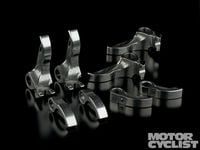Got a question for answers? Send it to mcmail@sorc.com
More Zinc?
Q **A valve check on my 2000 Ducati 748 found excessive wear on five of the rocker arms. The bike has approximately 16,000 miles on it and I've been using Motul 300v Factory Line oil. Megacycle re-built all 16 rockers, and strongly suggested using a zinc additive: ZDD Plus. The manufacturer, Navone, claims that over the last 10 years, all the zinc phosphate has been eliminated from most motor oils because it decreased the life of catalytic converters. Autos have apparently gone to roller cams to avoid valve-train damage. What do you think? Should I add zinc to all my bike oils? Besides the nominal cost, is there any downside?
**Mike Newman
San Luis Obispo, CA
A Though problems with other models are rare, some Ducati 748s and 916s did leave the factory with flaky rocker arms. When the hardfacing fails, the rest is sure to follow. Triple-check your clearances. It's easy to be spot-on at TDC and too tight somewhere else on the cam. And since any oil can take a minute or so to get up there, go easy on a cold engine.
According to Dave Wolman, President of Motul USA, even the best oil can't fix bad metallurgy. More zinc doesn't necessarily equal less wear. "This isn't an oil issue. It's about metal wiping off of the rocker. High amounts of Zinc might protect bad engineering for a while, but we can't recommend ZDD Plus or any other additive. There's no way of knowing if it will mix with our chemistry and remain stable without all sorts of testing. You can't add more of one thing without throwing off the rest of the formula. Our 300V starts with synthetic Ester bases-think liquid Kevlar-so we don't need lots of old chemistry or EP additives to get great performance."
Your 748 has no catalytic converter. If it did, adding zinc could trigger more trouble. Wolman says lots of zinc means lots of phosphorous. You can't have one without the other. Once phosphorous in the oil tops 1200 parts per million, there's enough in the exhaust to attack the precious metals inside your cat-usually platinum, rhodium and maybe some palladium-stopping the oxidation of carbon monoxide and unburned hydrocarbons. That's the problem with zinc and phosphorous. That's also why phosphorous levels in JASO MA-certified oils are kept between 800-1200 ppm. The engine has to actually consume phosphorous to damage exhaust components like oxygen sensors and catalytic converters. The thinner SM oils you're talking about-5w-30 or 10w-30-get less phosphorous because they're more likely to get past the rings and burn, potentially fouling up the expensive bits downstream. New cars use roller cams because they're more efficient. Engineers have a fancy word for that: progress.
Gone Soft
I just picked up a very clean, very stock '04 Honda RC51 from a friend of a friend who somehow ended up with two. I know Nicky Hayden's signature on the tank is there because he took the '03 AMA Superbike Championship, but why is Woody Woodpecker above the front turn signals? Also, my friend's friend mentioned something about a soft rev-limiter. I'm clear on the basic rev-limiter concept, but what's a soft one? Fill me in when you get a minute.
Michel Gosselin
Frederick, MD
_Created way back in 1940 by Ben Hardaway, Woody Woodpecker was drafted as the official mascot for American Honda's Superbike, supercross and motocross teams back in 2000 when Universal Studios signed on as a sponsor. The soft rev-limiter on Honda's U.S.-spec RC51 starts tapering ignition advance between 9200 rpm and the hard limiter that pulls the plug altogether at 10,200. RC51s sold in other parts of the world are unafflicted, and our long-term bike ran perfectly after we bypassed the soft circuitry using the excellent instructions available at www.RC51.org. After disabling the infamous vacuum-operated flapper valve, plugging in a Power Commander and slipping on a pair of Sato Racing exhaust cans, our bike made 129 rear-wheel horses: 6 more than the stock bike's 123 bhp at 9250 rpm. The 999cc twin seemed happier than ever. You can enable the soft limiter again at any time. _
School of Hard Rock
I traded in my old '95 Harley Road King for an '09 BMW R1200GS after the local dealer made me an offer I couldn't refuse. The optional low seat made me more confident. Putting both feet flat on the ground is a good thing. After 1300 miles on the street, I'm itching to get dirty, but I want to do it right. Making mistakes way out in the middle of nowhere on something this big would be painful-and expensive. What's the best way to learn how to ride one of these beasts right? Magazine articles are nice, but-no offense-they're not quite enough in this case.
Kim Walsh
Los Angeles, CA
_If you want a posh weekend vacation disguised as an off-road education, there are other choices, but if you really want to learn how to handle a big, heavy adventure bike, there's the Jimmy Lewis Off-Road Riding School. In the spirit of full disclosure, Lewis is Editor-in Chief of Motorcyclist's sister publication, Dirt Rider. He's also one of the most gifted off-road riders you'll ever meet, having finished third in the Paris-Dakar Rally on a BMW R900RR and earning four ISDE gold medals. Following his retirement from racing, Lewis has become an excellent teacher-you'll learn more in one weekend from him and his instructors than you ever could from a book. A two-day class costs about $600. Check www.jimmylewisoffroad.com for details. _














/cloudfront-us-east-1.images.arcpublishing.com/octane/VZZXJQ6U3FESFPZCBVXKFSUG4A.jpg)
/cloudfront-us-east-1.images.arcpublishing.com/octane/QCZEPHQAMRHZPLHTDJBIJVWL3M.jpg)
/cloudfront-us-east-1.images.arcpublishing.com/octane/HXOUJXQWA5HBHGRO3EMJIGFMVI.jpg)

/cloudfront-us-east-1.images.arcpublishing.com/octane/3TIWWRV4JBBOLDVGRYECVVTA7Y.jpg)
/cloudfront-us-east-1.images.arcpublishing.com/octane/KIX5O23D5NAIBGFXBN3327DKZU.jpg)
/cloudfront-us-east-1.images.arcpublishing.com/octane/7GJYDUIPXRGMTMQKN6ONYOLBOU.jpg)
/cloudfront-us-east-1.images.arcpublishing.com/octane/MUQLOVLL2ZDGFH25ILABNBXKTI.jpg)
/cloudfront-us-east-1.images.arcpublishing.com/octane/TNOU5DNE2BC57MFPMGN2EIDXAM.jpg)
/cloudfront-us-east-1.images.arcpublishing.com/octane/GTCXACQGJ5HAPDTGWUQKDEH44E.jpg)
/cloudfront-us-east-1.images.arcpublishing.com/octane/S35YGSEMEZB4BLTDJTSZPF4GLA.jpg)
/cloudfront-us-east-1.images.arcpublishing.com/octane/5UOT6HPX2JFMRJAX6EH45AR4MQ.jpg)
/cloudfront-us-east-1.images.arcpublishing.com/octane/OKWOJWAKP5EP3OACCRRWPCIX2Q.jpg)
/cloudfront-us-east-1.images.arcpublishing.com/octane/2WF3SCE3NFBQXLDNJM7KMXA45E.jpg)
/cloudfront-us-east-1.images.arcpublishing.com/octane/G4MG6OUCJNBSHIS2MVVOTPX65E.jpg)
/cloudfront-us-east-1.images.arcpublishing.com/octane/IIGGWFOTOJGB7DB6DGBXCCMTDY.jpg)
/cloudfront-us-east-1.images.arcpublishing.com/octane/QSTCM6AVEZA5JJBUXNIQ3DSOF4.jpg)
/cloudfront-us-east-1.images.arcpublishing.com/octane/U4I7G625B5DMLF2DVIJDFZVV6M.jpg)
/cloudfront-us-east-1.images.arcpublishing.com/octane/B6XD6LS6IVCQPIU6HXDJSM3FHY.jpg)
/cloudfront-us-east-1.images.arcpublishing.com/octane/ICL63FEDDRDTTMINYICCEYGMDA.jpg)
/cloudfront-us-east-1.images.arcpublishing.com/octane/FCGZHQXRBZFLBAPC5SDIQLVF4I.jpg)
/cloudfront-us-east-1.images.arcpublishing.com/octane/WNOB6LDOIFFHJKPSVIWDYUGOPM.jpg)

/cloudfront-us-east-1.images.arcpublishing.com/octane/X33NU3E525ECRHXLNUJN2FTRKI.jpg)